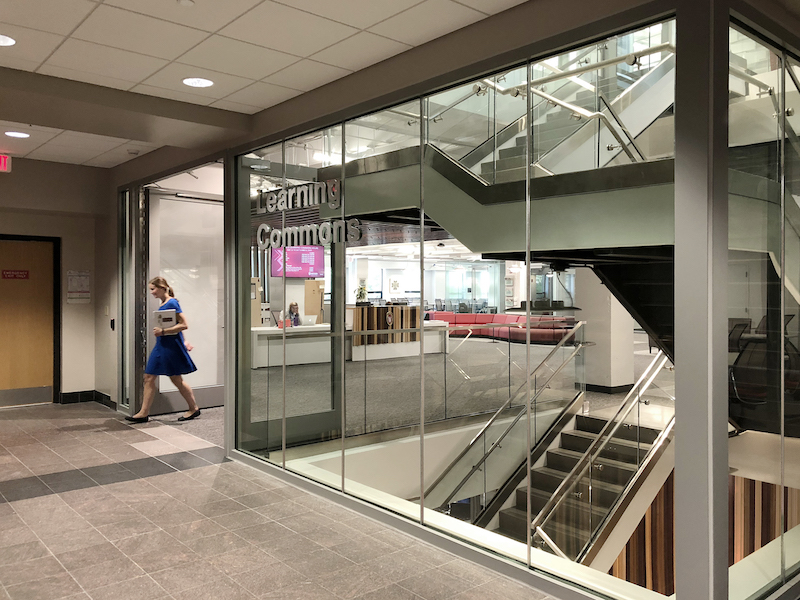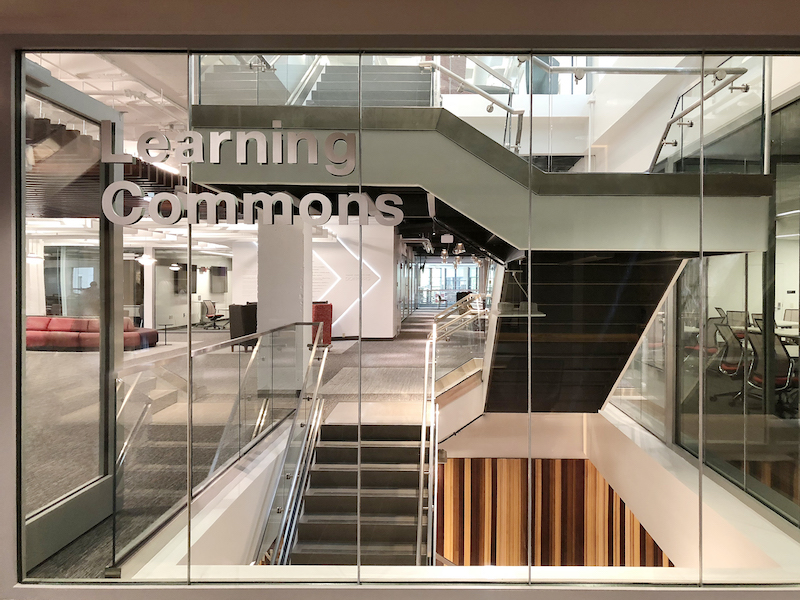When the University of Wisconsin School of Business officially opened the Learning Commons last May, it kicked off the first step in realizing the university’s grand masterplan to renovate the library buildings across the Madison campus. “The design strategy for this Learning Commons space included connecting the east and the west wings of Grainger Hall. Transparency was a key principle for making this happen,” says Scott Kammer, AIA at Potter Lawson. Incorporating transparency between spaces extended to the stairwells as well. To meet the design intent and code requirements, the architects decided to use clear, fire resistive glass walls.
Traditionally, stairwells have been relegated to the back of the building and usually reserved for emergencies as their dark, isolated surroundings made it unappealing for everyday use. The lack of vision and transparency also made it a prime spot for attacks. This all changed with the advent of clear, fire resistive glazing able to meet the ASTM E-119/UL 263 wall standard up to 2 hours. Using transparent building materials that incorporate vision and code-compliance made it possible to design stairwells that are more centrally located instead of being tucked away in the back.
This was the case for the Learning Commons. “The existing building had two separate stairs that only connected two floors each. The centrally located stairwell connected all three levels of the Learning Commons and contributed to the wayfinding experience for the users. It was critical for this stairwell to be as clear as possible to see through the space,” adds Scott.
 Image created by MSR.
Image created by MSR.
During the design phase, Scott worked with Mike White at SAFTI FIRST to explore his options. “Mike was very responsive and answered our questions in a timely manner. He included photos of similar projects, which helped us specify exactly what we needed. He was very helpful in determining if the products would work with our budget at an early stage of design,” says Scott.
To achieve maximum transparency while meeting code requirements, the architects specified 9 ft. tall, clear, fire resistive butt-glazed walls using SuperLite II-XLM in GPX Architectural Series perimeter framing. Instead of vertical mullions, SuperLite II-XLM uses a slim, 6mm butt-joint between the fire resistive glass panels to allow as much transparency as possible while still meeting the fire resistive ASTM E-119/UL 263 wall requirement.
The entrances to the stairwell also maximized vision and transparency without sacrificing safety. Building codes in the USA limit ceramics and other fire protective glazing to 100 sq. in. in the vision panels of 60-90 minute doors in interior exit stairways, ramps and exit passageways regardless if the building is fully sprinklered. To exceed the 100 sq. in. door vision panel limitation, fire resistive glazing tested to ASTM E-119/UL 263 must be used.
 Photo: Olivia Nass.
Photo: Olivia Nass.
That’s exactly what the architects did for this project. For maximum vision and transparency, they specified full-vision temperature rise doors using an ASTM E-119/UL 263 rated assembly comprised of GPX Architectural Series Doors with SuperLite II-XL glazing. The doors also matched the 9-ft. height of the clear, fire resistive butt-glazed panels adjacent to it. With other aluminum temperature rise doors having a maximum height of 8 ft. tall, going with the GPX Architectural Series aluminum temperature rise door at the full 9 ft. height eliminated the need for a transom above the door. These doors do not require a mid-rail and were supplied with custom access hardware at the architect’s request for enhanced security.
SAFTI FIRST worked closely with Omni Glass & Paint during the installation phase. Even though fire resistive butt-glazed walls are a relatively new product in the market, the installation was a pretty smooth process. “I spoke with our installers and they did not see much of a difference in the captured and butt-glazed systems as far as ease of installation,” says Robert Leffel of Omni Glass & Paint. “The service from SAFTI FIRST was good. They did all they could to minimize delays,” he adds. SAFTI FIRST’s sales and project management teams were in constant communication with Omni throughout the bidding, submittal, fabrication and delivery stages.
The result is a visually stunning, code-compliant stairwell enclosure that helps connect the various spaces in this state-of-the-art Learning Commons that is sure to be enjoyed by students, faculty and visitors for years to come.
Related Stories
| Oct 12, 2010
Building 13 Naval Station, Great Lakes, Ill.
27th Annual Reconstruction Awards—Gold Award. Designed by Chicago architect Jarvis Hunt and constructed in 1903, Building 13 is one of 39 structures within the Great Lakes Historic District at Naval Station Great Lakes, Ill.
| Oct 6, 2010
Windows Keep Green Goals in View
The DOE's National Renewable Energy Laboratory has almost 600 window openings, and yet it's targeting LEED Platinum, net-zero energy use, and 50% improvement over ASHRAE 90.1. How the window ‘problem’ is part of the solution.
| Sep 16, 2010
Gehry’s Santa Monica Place gets a wave of changes
Omniplan, in association with Jerde Partnership, created an updated design for Santa Monica Place, a shopping mall designed by Frank Gehry in 1980.
| Sep 13, 2010
Triple-LEED for Engineering Firm's HQ
With more than 250 LEED projects in the works, Enermodal Engineering is Canada's most prolific green building consulting firm. In 2007, with the firm outgrowing its home office in Kitchener, Ont., the decision was made go all out with a new green building. The goal: triple Platinum for New Construction, Commercial Interiors, and Existing Buildings: O&M.
| Sep 13, 2010
Committed to the Core
How a forward-looking city government, a growth-minded university, a developer with vision, and a determined Building Team are breathing life into downtown Phoenix.
| Aug 11, 2010
New data shows low construction prices may soon be coming to an end
New federal data released recently shows sharp increases in the prices of key construction materials like diesel, copper and brass mill shapes likely foreshadow future increases in construction costs, the Associated General Contractors of America said. The new November producer price index (PPI) report from the Bureau of Labor Statistics provide the strongest indication yet that construction prices are heading up, the association noted.
| Aug 11, 2010
Using physical mockups to identify curtain wall design flaws
Part two of a five-part series on diagnosing and avoiding cladding, glazing, and roofing failures from building forensics expert IBA Consultants.
| Aug 11, 2010
Best AEC Firms of 2011/12
Later this year, we will launch Best AEC Firms 2012. We’re looking for firms that create truly positive workplaces for their AEC professionals and support staff. Keep an eye on this page for entry information. +












